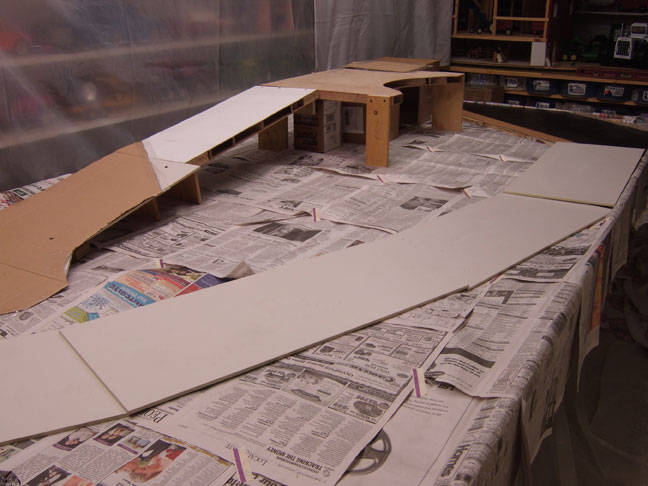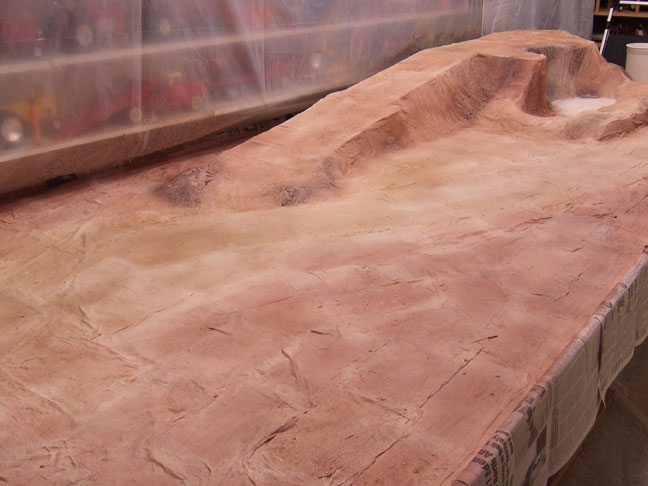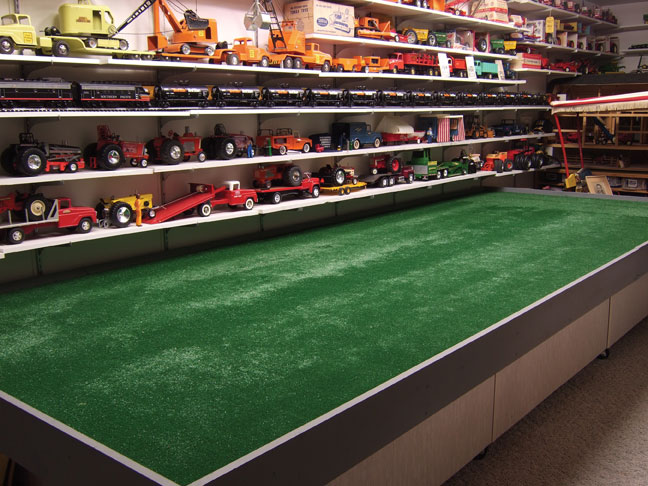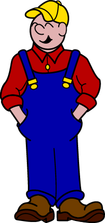Note: This feature was printed in the Sept. TT&C 2011 issue.
| Terry Johnson is shown with some of his Smith-Miller by Thompson collection. Scrap wood is used to make the ramps and roads. Plaster is messy so the models on the shelves are protected by plastic. If you are modeling the Star Wars ice planet Hoth you are done at this point. For all other projects, you’ll need to add color. Once the color is applied, the diorama starts to take shape. A 5-foot-by-14-foot former slot car table was used for the diorama. Adding dirt and vehicles is the final step. The finished display is shown with some of Terry’s collection on shelves in back. More photos available in the Sept. TT&C 2011 magazine. Call (701) 883-5206 to purchase. | Having built and operated model railroads for decades, I was always a little disappointed in just displaying my Tonka truck collection on shelves. I guess I wanted to play with them like I do my trains, but carpet trucking is a little harder now than when I was 10 years old. I suspect my imagination is not as keen either. Maybe it’s harder for me to pretend that a cardboard tube is a culvert or maybe I’m just demanding more realism. Either way, I decided to build a diorama to enable me to play with my truck collection as an adult. Several years ago, I built what I call a hobby table. It measures about 5 feet by 14 feet and stands 2 feet off the floor. It was intended as a versatile platform suitable for a variety of toys. It could be used to set up my two sons’ Star Wars action figures and vehicles or maybe the Playmobil sets they had acquired. The low height and sturdy construction would allow them to climb up on the table and play. Casters helped the table to be easily moved. As it turns out, the table was built a little late in their toy journey. Music and video games had by then occupied most of their free time. Like any good father, I had a backup plan, and I set up a 1/32 scale slot car track to cover the platform. That was a lot of fun, but my truck collection continued to call out to me. My Tonka collection started when I was about 4 years old. We lived in Tucson, Ariz., and I asked for Tonka trucks each Christmas. About six trucks into my collection, Mom and Dad informed me they were moving to Michigan in a small U-Haul truck. There wouldn’t be room for my toys or even my dog. I thought long and hard about asking them to leave my older sister and brother behind, but decided it would be fruitless. They were needed to help drive! Twenty years or more passed before I stumbled onto a table of Tonka trucks at an antique show. I had no idea people collected them and they were still available, although not for $5.98 anymore. I started by only purchasing the toys I had as a kid. Then I decided I should have some nicer trucks like my friends had that we couldn’t afford when I was growing up. I also found some neat Tonka trucks I didn’t even know existed before. Everything came back to me, as I remembered the sturdy steel construction and the smell of rubber tires. I didn’t stop at Tonkas either. Smith-Miller trucks were even cooler, and Doepke and Tru-Scale made some nice trucks as well. My trains had serious competition for my hobby dollars. Finally, on the first day of 2011, I packed away the slot car set and designed a 1/16 scale diorama to allow me to display my trucks in a realistic setting. It would still need to be versatile. I wanted to model a concrete foundation under construction and also a gravel pit. There had to be elevation changes and reasons to include my Doepke Heiliner, Euclid and Wooldridge earthmovers. I also wanted a short piece of highway to display various on-road trucks. My experience with model railroads made scenery building a snap. The first preparation was to make sure the hobby table could be easily returned to slot car use. I covered the grass carpeting with heavy gauge plastic, which gave me a waterproof barrier. Following that, is a layer of newspapers which gives the plaster something to adhere to. The elevated area and ramp needed to be constructed of something heavy enough to support the large toys. I used spare pieces of wood to provide the necessary strength. Both the highway and dirt road that runs diagonally through the scene use plywood for their base. This gives me a sturdy area that I can walk on without ruining any scenery. The technique I used for scenery construction is called hard shell. Crumpled newspaper, Styrofoam or most anything can be used to form hills and berms. Masking tape holds it all in place. I soaked paper towels in plaster, actually dental lab stone, and draped them over everything on the platform. After the plaster had hardened, I used an old paintbrush to apply an additional coat to the towels which helps hide the embossed texture. To read the rest of this story, call (701) 883-5206 or 1-800-533-8293 to order the Sept. TT&C 2011 issue. Other features included in the Sept. 2011 issue: • A Rocky Mountain Highway by Diana West • Nostalgia Rules In Mike’s Dioramas by Dee Goerge • Fire Trucks and Firemen Need Homes Too by Richard Marmo • Collector Update Checklist by Ray Crilley |







 RSS Feed
RSS Feed
